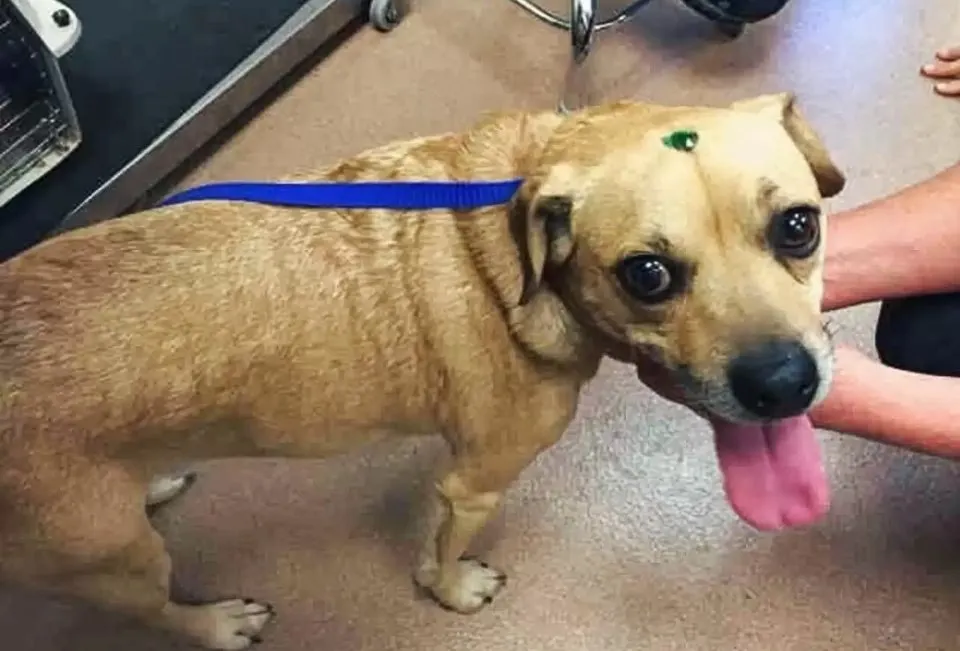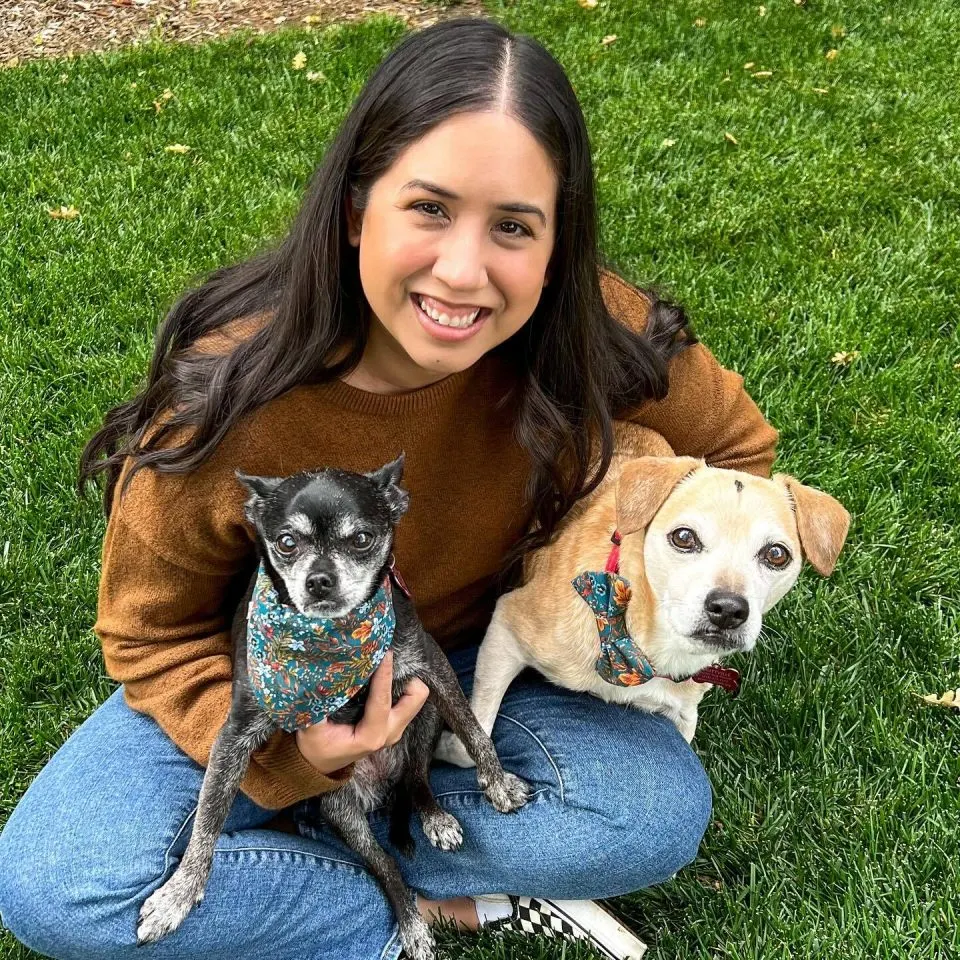When Peanut Butter and Jelly were picked up from the streets and brought to Sonoma County Animal Services, in California, they attracted a lot of attention.
As soon as they arrived at the shelter, the staff noticed that there was something shiny on their foreheads.
When the shelter staff approached the pups, they were both shocked and confused when they realized that the dogs had jewelry glued to their foreheads.
Although many of the shelter members had worked in animal care for a long time, they had never seen something like that before.
The Adorable Duo Finds A Home

Peanut Butter is a Beagle and Pug mix, and Jelly is a female Chihuahua mix. They arrived at the shelter in 2015, and the vet team decided that the jewels and the glue had to be removed. They wanted to make sure the glue didn’t contain any harmful substances.
After the glue was removed, it was determined that it didn’t cause any damage to the canines’ health. However, Peanut Butter and Jelly had a secondary burn and they were left with scars on their foreheads.

Other than that, the canines were alright, and they were eager to find their forever parents and start a new life.
The doggos were happy when a wonderful family came along and gave them a wonderful home. Their family loved them and took care of them. Sadly, after their owner passed away, the pups had no one else to care for them.
At The Shelter Once Again

They were brought back to Sonoma County Animal Services.
Since Peanut Butter and Jelly were now seniors, they were transferred to Muttville Senior Dog Rescue, a non-profit organization located in San Francisco that helps dogs over the age of 7 find their forever home.
Their foster mom, Lisa Arden, took great care of them. She cuddled with them and gave them all her love.
“They are very sweet and friendly dogs who are great around people and get along well with other dogs. They continue to blossom in foster, showing both of their silly personalities. They are both still quite active and love to run around and play. They are just the most wonderful dogs,” Arden told The Dodo.
Although both dogs had big personalities, Arden said that Jelly was the boss of Peanut Butter. She liked telling him what to do.
A Forever Home

After spending three months in foster care without receiving any adoption applications, their foster mom made a TikTok video about the two canines. She introduced them to her followers, wishing to increase their pool of potential adopters.
The video went viral. The lovely pups and their magnetic personalities stole the hearts of many people online.
On October 26th in 2023, Arden shared great news on her Instagram. Peanut Butter and Jelly had a virtual meet and greet with their new dad. They had an amazing time.
Arden said that she was certain that the doggos found the best possible home. They can’t wait for the adoption to be finalized, and for them to ride into the sunset with their new dad.
We’re thrilled that the lovely pooches found their forever home, and we wish them many adventures with their new dad.
Ever noticed your furry friend barking away in their sleep? It’s a common sight that can leave you wondering what’s going on in that doggy dreamland. As a seasoned dog trainer, you’re no stranger to the quirky behaviors our canine companions exhibit, and this one is no exception. Dogs barking in their sleep can be both amusing and intriguing, offering a glimpse into their inner world that’s not always easy to decipher.
While your pooch snoozes peacefully, their vocalizations may range from soft whimpers to full-on barks, making you wonder what prompts these dream-time outbursts. As you observe your four-legged buddy in this curious state, you can’t help but ponder the reasons behind their nighttime serenades. Stay tuned as we delve into the fascinating realm of why dogs bark in their sleep, unraveling the mysteries behind this endearing yet enigmatic behavior.
Understanding Dog Sleep Behavior
The Sleep Cycle of Dogs
Understanding dog sleep behavior involves knowing their sleep cycle. Dogs have similar sleep cycles to humans, going through stages of light sleep, deep sleep, and REM (rapid eye movement) sleep. During REM sleep, dogs may display muscle twitches, eye movements behind closed lids, and yes, even occasional barking.
Comparing Human and Canine Sleep
Comparing human and canine sleep patterns reveals some interesting differences. Dogs tend to have shorter sleep cycles than humans, which is why they may experience more frequent awakenings during the night. Unlike humans, who consolidate their sleep into one long period at night, dogs often have multiple naps throughout the day, adding up to their total sleep time. Understanding these variations can shed light on why dogs bark in their sleep – it’s simply a part of their natural sleep behavior.
Reasons Behind Canine Nocturnal Vocalizations
Dreaming in Dogs
Dogs, like humans, can dream during their sleep. When your furry companion is in the REM (rapid eye movement) stage of sleep, they may exhibit behaviors indicative of dreaming. Just as you may vocalize or move during dreams, dogs might bark, whimper, or twitch in their sleep. This natural occurrence is a reflection of their mental activity during rest.
External Stimuli and Sensory Responses
External stimuli can play a significant role in causing dogs to vocalize during sleep. Your dog’s acute senses may pick up sounds, smells, or sensations present in their environment, leading to vocal responses even while asleep. This heightened sensory awareness can trigger barking or growling as a reaction to perceived stimuli, adding to the nocturnal vocalizations.
Health Issues and Sleep Disorders
Occasionally, health issues or sleep disorders can also contribute to dogs barking in their sleep. Conditions like sleep apnea, anxiety, cognitive dysfunction, or pain can disrupt your dog’s rest, prompting vocalizations during the night. If your dog’s nocturnal vocalizations become frequent or intense, it’s essential to consult with a veterinarian to rule out any underlying health concerns and ensure your pet’s well-being.
Analyzing the Types of Barks in Sleep
Soft Barks and Whimpers
When your furry friend lets out soft barks or whimpers during sleep, it’s often a sign of something pleasant in their dream world. These gentle sounds may indicate that they are experiencing a peaceful dream, like chasing butterflies or playing fetch.
Loud and Aggressive Barking
On the other hand, loud and aggressive barking during sleep can suggest a more intense dream state. Your dog might be engaging in a vivid dream where they feel the need to protect their territory or warn off an imaginary intruder. This type of barking is usually more pronounced and can sometimes be accompanied by body movements indicating heightened emotional involvement.
Remember, understanding the types of barks your dog produces in their sleep can give you insight into their inner experiences and help you decipher their dreams better.
The Impact of Sleep Barking on Dog Health
Potential Disruptions in Sleep Quality
When your dog barks in their sleep, it can disrupt their sleep quality, leading to a less restful slumber. Just like humans, dogs need uninterrupted sleep to stay healthy and happy. Constant barking during sleep might indicate underlying issues affecting their sleep patterns. If this behavior persists, it could result in daytime fatigue and irritability for your furry friend.
Stress and Anxiety Considerations
Sleep barking in dogs could be a sign of stress or anxiety. Dogs, like humans, can carry their worries into their dreams, causing them to vocalize their concerns while asleep. If your dog frequently barks during sleep, it might be worth observing their behavior during the day for signs of stress or anxiety. Addressing these underlying emotional issues can improve their overall well-being and reduce nocturnal disturbances.
How to Respond to Your Dog’s Sleep Barking
Creating a Comfortable Sleep Environment
To help your dog with sleep barking, ensure they have a cozy sleeping spot. Create a peaceful atmosphere by providing a comfortable bed in a quiet, dark room. Limit any disturbances that could interrupt your dog’s sleep, such as loud noises or bright lights. A calm environment can promote deeper and more restful sleep, reducing the chances of disruptive barking episodes.
When to Consult a Veterinarian
If your dog’s sleep barking becomes excessive or is accompanied by other concerning behaviors, it’s essential to seek advice from a veterinarian. Persistent sleep barking could be a sign of underlying health issues like anxiety or pain that require professional attention. A veterinarian can evaluate your dog’s overall health and behavior to determine the best course of action to address the sleep barking and ensure your furry friend’s well-being.
Conclusion
So, next time you catch your furry friend barking in their sleep, remember it’s all part of their dreaming adventures. Whether they’re chasing squirrels or protecting the house, your pup’s nighttime vocalizations are just a glimpse into their dream world. By creating a cozy sleep environment and keeping an eye on any excessive barking, you can ensure your dog has sweet dreams and a restful night’s sleep. And if you ever have concerns about your dog’s sleep behavior, don’t hesitate to reach out to your veterinarian for guidance. Happy dreaming, both to you and your four-legged companion!
Frequently Asked Questions
Why do dogs bark in their sleep?
Dogs bark in their sleep due to dreaming during the REM stage, expressing behaviors like barking, whimpering, or twitching.
What triggers dogs to bark while sleeping?
External stimuli or sensory responses can trigger dogs to vocalize while sleeping, showcasing their sensory awareness.
Can health issues lead to dogs barking in their sleep?
Yes, health issues like sleep disorders, anxiety, or pain can contribute to dogs barking in their sleep.
How should I respond to my dog’s sleep barking?
Create a comfortable sleep environment for your dog, offering a cozy sleeping spot with minimal disturbances. Consult a veterinarian if excessive barking persists.
[no_toc]

Hey there, I’m Janet Brooks, a dog-loving student from California. I’m all about helping pups in need, especially those without homes. Me and my awesome friends work together to give shelter and love to stray dogs. Oh, and I also write blogs about dogs to share helpful info.